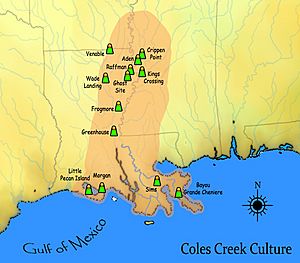Coles Creek culture facts for kids
The Coles Creek culture was a group of Native American people who lived in the Lower Mississippi River valley. This was during a time called the Late Woodland period, from about 700 to 1200 CE. They lived in parts of what is now Arkansas, Louisiana, and Mississippi.
The Coles Creek culture came after the Troyville culture. It was a time of big changes in the area. More people lived there, and their society became more organized. By the end of this period, around 1000 CE, some groups started to form simple chiefdoms. These were societies led by powerful chiefs. The Coles Creek culture is seen as the ancestor of the later Plaquemine culture.
Contents
What Made Them Special?
The Coles Creek culture grew right out of the local traditions in the Lower Mississippi Valley. It was a step between the older Woodland period and the newer Plaquemine culture.
One of the main things that changed was how they built their mounds. They started building flat-topped platform mounds. These mounds were often placed around open areas called plazas. Their leaders and important buildings were on top of these mounds.
Their society became more complex, with clearer leaders and rules. For food, they still mostly relied on hunting and gathering wild plants. They also grew some crops from the Eastern Agricultural Complex, like certain seeds. They didn't grow much maize (corn) yet, which became very important later.
The name "Coles Creek culture" comes from the special designs on their pottery. An archaeologist named James A. Ford studied pottery from sites like Mazique and Coles Creek. He decided to name the culture after the Coles Creek Site.
How They Built Things
In earlier times, mounds were mostly for burying the dead. But during the Coles Creek period, mounds changed. They became places to build temples and other important community buildings. These mounds were shaped like pyramids with flat tops. They often had ramps leading up to the top. People would build these mounds over many years, adding new layers. On top, they built structures, usually made from "wattle and daub". This means they wove sticks together (wattle) and then covered them with mud or clay (daub).
A typical Coles Creek village usually had at least two, and often three, mounds. These mounds were arranged around a central open space, or plaza. This way of planning villages started around 800 CE and lasted for hundreds of years. Later in the Coles Creek period, some sites grew even larger, with up to six mounds. Important sites from this time include Mount Nebo, Holly Bluff, Kings Crossing, and Lake Agnes.
Many Coles Creek mounds were built on top of older burial mounds. Scientists think that new leaders might have done this to show their power. It was like they were connecting themselves to the respected ancestors of the past.
Their Daily Lives and Tools
People of the Coles Creek culture didn't trade much over long distances. So, you don't find many items from far away at their sites. They also didn't grow many crops until the very end of their period.
Their main food was acorns. They also ate persimmons, palmetto, and starchy seeds like maygrass. They might have even "managed" some wild plants to make sure they had a good food supply. They found very little corn at first. But by 1000-1200 CE, they started growing more corn. Still, it wasn't as much as people would grow in the later Mississippian culture period.
A new hunting tool, the bow and arrow, became popular during this time. However, the older atlatl (a tool for throwing spears) was still used.
Their pottery also changed. They started making stronger pots that could be used for more things. They mixed wet clay with dry clay particles. This stopped the pots from cracking when they were fired. Most pots were only decorated on the top half. They used designs made by scratching lines or pressing tools into the clay. The pots were usually tan, black, brown, or gray. Sometimes, they found rare red pots or pots shaped like animals or people (called effigy pots).
Some Coles Creek Culture Sites
| Site Name | Image | What It Is |
|---|---|---|
| Bayou Grande Cheniere Mounds | 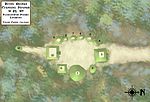 |
A large group of twelve mounds in Plaquemines Parish, Louisiana. These are from the Coastal Coles Creek culture. |
| Feltus Mound Site | A group of three mounds, built between 700 and 1000 CE. They are clustered around a central plaza. This site is north of Natchez, Mississippi. | |
| Frogmore Mound Site |  |
A site from the Late Coles Creek period in Concordia Parish, Louisiana. |
| Greenhouse site |  |
A site with many mounds in Avoyelles Parish, Louisiana. It dates from the Troyville-Coles Creek Period. |
| Kings Crossing site |  |
This site is important for the Kings Crossing phase (900 -1050 CE). It has many mounds and is near Vicksburg, Mississippi. |
| Mazique Archeological Site | 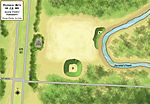 |
A site with many mounds in Adams County, Mississippi. It was used during the Coles Creek period (700-1000 CE) and later by the Natchez people. |
| Mott Mounds | 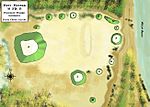 |
A large site with many mounds in Franklin Parish, Louisiana. It was mainly used during the Coles Creek period. |
| Peck Mounds | 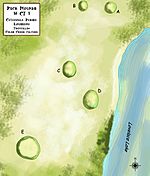 |
A site with many mounds from the Late Troyville-Early Coles Creek period in Catahoula Parish, Louisiana. |
| Raffman site | 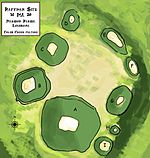 |
A site with many mounds in Madison Parish, Louisiana. It was mainly used during the Balmoral Phase (1000-1100 CE). |
| Sims site | A site with many mounds in St. Charles Parish, Louisiana. People from the Coles Creek culture first lived here around 800 CE. | |
| Troyville Earthworks |  |
A large site with many mounds in Jonesville, Louisiana. It once had the tallest mound in Louisiana, at 82 feet (25 meters) high. |


